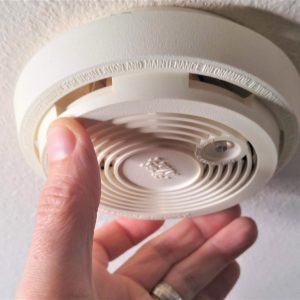
The classic annual changing color of the leaves, the cool crisp air, means autumn is almost here, and so is the usual reminder to “fall back” (“spring forward, fall back” as the phrase is commonly used), meaning that for all clocks that do not need to be physically reset, 2 am will become 1 am. Fall back also means this is the time of the year to check smoke detectors.
While checking on smoke detectors may seem like a small item on the checklist, they DO save lives. When they are faulty, lives are at risk.
Every year, approximately 2,000 people lose their lives to residential fires. It is therefore our direct responsibility as home inspectors to keep our customers safe. Educating our customers is just part of our roles as inspectors. As a certified home inspector myself, I am dedicated to superb customer service, so education becomes a crucial role when I discover the need for smoke detector remediation or replacement.
Sealed long life batteries power some smoke detectors. Because the batteries lose power over time, the entire unit should be replaced at least every 10 years or so. Smoke detectors powered by replaceable batteries, usually a 9-volt, need regular replacement. Be sure to test smoke alarms once a month to ensure proper working order and replace batteries twice a year. An easy reminder is to change batteries when you change the time on clocks for daylight-saving time every fall, aka fall back. In addition, it is highly recommended to have multiple smoke detectors in the home, for better safety, especially for dwellings with multiple floors. Bedroom areas need smoke detectors nearby, as well as one in each bedroom, to give residents timely notification to leave the home as quickly as possible. Smoke detectors can be connected to the home’s wiring system or powered by battery. Connected smoke alarm systems may have a battery backup to sustain function in the event of a power outage.
Types of Smoke Alarms: Smoke alarms are configured in two main ways. By understanding the differences, you can understand when there is a need for additional alarms in the house, and the best placement around the house for each type of smoke alarm. FYI, each type of smoke alarm performs differently in different types of fires. Depending on the type of alarm, it may use multiple sensors, and sometimes these sensors detect carbon monoxide or heat in addition to smoke. Also, both types of smoke detectors can pass the voluntary standard for smoke alarms, but they perform differently. In addition, it is recommended that you install both types of detectors, ionization and photoelectric, on every level of the home.
Ionization Detectors
These smoke alarms have a chamber containing two plates that generate a small, continuous electric current. When smoke particles enter the chamber, they disrupt the current flow. When the current stops, the alarm triggers. Ionization detectors respond quickly to flaming fires that give off heat and hot gases that give off smaller combustion particles.
Photoelectric Detectors
A light beams on a receptor (photocell) in these types of alarms. This type of smoke detector works one of two ways: When smoke enters the chamber, either the light is reduced or increased, depending on the configuration. Either way, the photocell responds to the increase or decrease of light and triggers the alarm.
Photoelectric detectors respond more quickly to smoldering fires that emit larger combustion particles.
Cooking can cause nuisance alarms with ionization detectors. It is advisable instead to use photoelectric detectors near the kitchen to avoid false alerts, but advise using ionization detectors in the home because kitchen fires are often fires with fast flames.
Combination Detectors
With dual sensor smoke detectors, they combine ionization and photoelectric sensors into one unit. These smoke detectors alert residents quickly to either quick flames or slow smoldering fires.
Lastly, as a family unit, be sure to create evacuation procedures and hold quarterly practice evacuation drills periodically in your home. Add value to your advice by suggesting that your client create evacuation procedures and hold quarterly practice evacuation drills.
